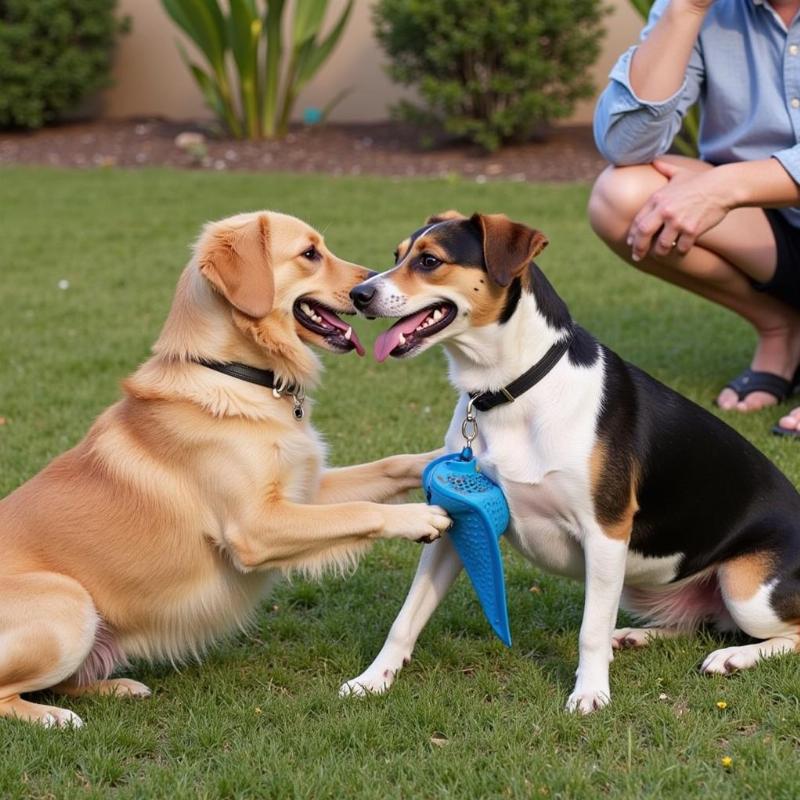Play fighting is a common behavior in dogs, and it’s often a source of concern for owners. Is it harmless fun, or a potential disaster waiting to happen? Understanding the difference between healthy play and true aggression is crucial for responsible dog ownership in the US. This article will help you decipher your dogs’ behavior and determine when to intervene.
Decoding Doggy Play: Is it Real or Just for Show?
It’s perfectly normal for dogs to engage in playful wrestling, chasing, and even some mouthing. This helps them develop social skills, expend energy, and strengthen their bond. However, it’s essential to differentiate play from actual aggression. Look for these signs of healthy play:
- Loose, wiggly body language: Stiffness or tense posture can indicate real aggression.
- Play bows: A bowed head and raised rear end is a classic invitation to play.
- Role reversal: Dogs will take turns being on top during play. If one dog is consistently dominant, it could be a sign of bullying.
- Inhibited bites: Playful bites are gentle and don’t cause injury.
- Breaks and pauses: Dogs will take breaks during play, which helps prevent escalation.
If you observe these behaviors, your dogs are likely just having fun. However, if the play becomes too rough or one dog seems uncomfortable, it’s time to step in.
When Play Turns Sour: Recognizing Signs of Aggression
Sometimes, play can escalate into aggression. Be vigilant for these warning signs:
- Hard bites that break the skin: This is a clear sign that the play has gone too far.
- Constant growling and snarling: While some vocalization is normal during play, excessive or intense growling can indicate aggression.
- Pinned down, unable to escape: One dog trapping the other indicates a power imbalance and potential bullying.
- Whale eyes: If you see the whites of your dog’s eyes (also known as “whale eyes”), it means they are stressed and uncomfortable.
- Tucked tail: A tucked tail is a sign of fear or submission.
If you see any of these signs, intervene immediately. Separate the dogs calmly and redirect their attention to other activities.
Setting the Ground Rules for Safe Play
 Chó chơi đùa an toàn
Chó chơi đùa an toàn
To ensure safe play sessions, establish clear boundaries and supervise your dogs:
- Supervise all interactions: Never leave dogs unsupervised while playing.
- Interrupt and redirect if play gets too rough: A quick “time out” can prevent escalation.
- Provide plenty of toys: This can help redirect their energy and reduce the likelihood of conflict.
- Teach basic obedience commands: Commands like “leave it” and “come” are invaluable for managing play.
- Consider professional help: If you’re unsure about your dogs’ behavior, consult a certified dog trainer or veterinary behaviorist. They can provide personalized guidance based on your dogs’ individual needs.
Should You Ever Encourage Play Fighting?
It’s generally not recommended to actively encourage play fighting, especially if one dog is significantly larger or more dominant than the other. Even seemingly harmless play can inadvertently reinforce unwanted behaviors or lead to injuries. Focus on providing enriching activities like walks, training, and playing with toys that encourage healthy interaction.
Conclusion: Balancing Fun and Safety
Letting your dogs play fight can be beneficial for their socialization and development, but it’s crucial to monitor their interactions and recognize the difference between playful tussles and true aggression. By understanding the nuances of canine communication and establishing clear boundaries, you can ensure a safe and enjoyable play experience for your furry friends. Remember, a responsible dog owner is a proactive one.
FAQ
- Q: My dogs growl when they play. Should I be worried? A: Some growling is normal during play. However, if it’s accompanied by tense body language or hard bites, it’s time to intervene.
- Q: What should I do if my dogs start fighting for real? A: Never put your hands between fighting dogs. Try making a loud noise to startle them or use a barrier like a blanket to separate them. Contact your veterinarian immediately if either dog is injured.
- Q: How can I tell if my dogs are playing or fighting? A: Look for signs of relaxed body language, play bows, role reversal, and inhibited bites. Tense posture, hard bites, and constant growling are signs of aggression.
- Q: Is it okay to let my puppy play fight with an older dog? A: Supervise closely and ensure the older dog isn’t becoming annoyed or overwhelmed. Older dogs should be allowed to set boundaries with puppies.
- Q: My dogs are always fighting over toys. What can I do? A: Provide enough toys for each dog and supervise playtime. Teach them to “drop it” or “leave it” to prevent resource guarding.
- Q: Should I punish my dogs for play fighting? A: Punishment is rarely effective and can worsen the problem. Focus on interrupting and redirecting unwanted behavior.
- Q: When should I seek professional help for my dogs’ play fighting? A: If you’re unsure if their play is healthy or if it frequently escalates into aggression, consult a certified dog trainer or veterinary behaviorist.
Introducing Beautdogs.us
Beautdogs.us is your go-to resource for all things dog-related in the US. We provide expert advice on dog breeds, care, and product recommendations. Whether you’re a new dog owner or a seasoned pro, Beautdogs.us offers reliable information and valuable resources to help you provide the best possible care for your canine companion. Contact us today for personalized support. Email: [email protected], Phone: +1 501-555-7529.